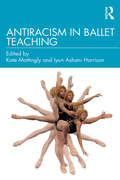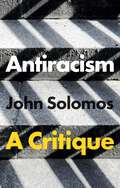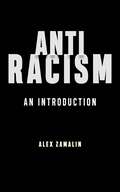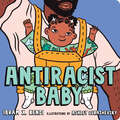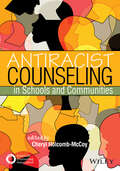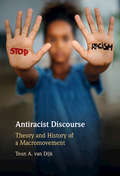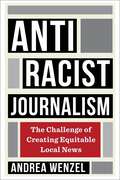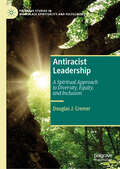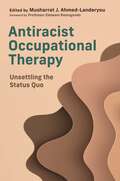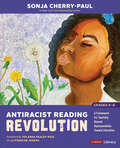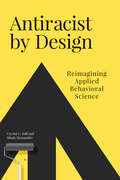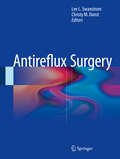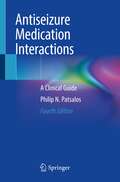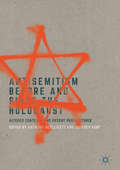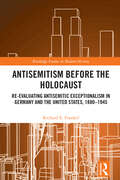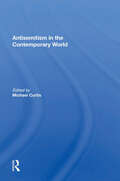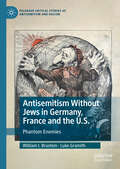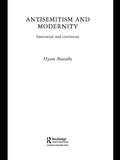- Table View
- List View
Antiracism in Ballet Teaching
by Kate Mattingly Iyun Ashani HarrisonThis new collection of essays and interviews assembles research on teaching methods, choreographic processes, and archival material that challenges systemic exclusions and provides practitioners with accessible steps to creating more equitable teaching environments, curricula, classes, and artistic settings. Antiracism in Ballet Teaching gives readers a wealth of options for addressing and dismantling racialized biases in ballet teaching, as well as in approaches to leadership and choreography. Chapters are organized into three sections - Identities, Pedagogies, and Futurities - that illuminate evolving approaches to choreographing and teaching ballet, shine light on artists, teachers, and dancers who are lesser known/less visible in a racialized canon, and amplify the importance of holistic practices that integrate ballet history with technique and choreography. Chapter authors include award-winning studio owners, as well as acclaimed choreographers, educators, and scholars. The collection ends with interviews featuring ballet company directors (Robert Garland and Alonzo King), world-renowned scholars (Clare Croft, Thomas F. DeFrantz, Brenda Dixon Gottschild), sought-after choreographers (Jennifer Archibald and Claudia Schreier), and beloved educators (Keesha Beckford, Tai Jimenez, and Endalyn Taylor). This is an essential resource for anyone teaching or learning to teach ballet in the Twenty First Century.
Antiracism: A Critique
by John SolomosWhile there has been a wealth of research and conversation about the role of racism in shaping our social, political and economic structures, antiracism – its highly publicized counterpart – has been very little studied, discussed or debated. Veteran race scholar John Solomos argues in this slim intervention that we urgently need to re-focus research and activist agendas to address this gap in knowledge. The core questions addressed in the book include: what does antiracism mean in the contemporary environment? How do states, political institutions and civil society define and practise antiracism? What is the role of alliances across race, class and gender in shaping possible futures beyond racism? Moving beyond the valuable work which has already uncovered the ways in which race and racism are made and re-made, these questions cut to how to develop meaningful political and policy initiatives framed by antiracist ideas and values. If we hope to make sense of the evolution of contemporary racisms in the world around us in order to tackle them head on, antiracism needs to be better understood.
Antiracism: An Introduction
by Alex ZamalinAn introduction to antiracism, a powerful tradition crucial for energizing American democracyOn August 12, 2017, in Charlottesville, Virginia, a rally of white nationalists and white supremacists culminated in the death of a woman murdered in the street. Those events made clear that racism is alive and well in the United States of America. However, they also brought into sharp relief another American tradition: antiracism. While racists marched and chanted in the streets, they were met and matched by even larger numbers of protesters calling for racism’s end. Racism is America’s original and most enduring sin, with well-known historic and contemporary markers: slavery, lynching, Jim Crow, redlining, mass incarceration, police brutality. But racism has always been challenged by an opposing political theory and practice. Alex Zamalin’s Antiracism tells the story of that opposition.The most theoretically generative and politically valuable source of antiracist thought has been the black American intellectual tradition. While other forms of racial oppression—for example, anti-Semitism, Islamophobia, and anti-Latino racism—have been and continue to be present in American life, antiblack racism has always been the primary focus of American antiracist movements. From antislavery abolition to the antilynching movement, black socialism to feminism, the long Civil Rights movement to the contemporary Movement for Black Lives, Antiracism examines the way the black antiracist tradition has thought about domination, exclusion, and power, as well as freedom, equality, justice, struggle, and political hope in dark times.Antiracism is an accessible introduction to the political theory of black American antiracism, through a study of the major figures, texts, and political movements across US history. Zamalin argues that antiracism is a powerful tradition that is crucial for energizing American democracy.
Antiracist Baby
by Ibram X. KendiA #1 New York Times Bestseller!From the National Book Award-winning author of Stamped from the Beginning and How to Be an Antiracist comes a fresh new board book that empowers parents and children to uproot racism in our society and in ourselves.Take your first steps with Antiracist Baby! Or rather, follow Antiracist Baby's nine easy steps for building a more equitable world.With bold art and thoughtful yet playful text, Antiracist Baby introduces the youngest readers and the grown-ups in their lives to the concept and power of antiracism. Providing the language necessary to begin critical conversations at the earliest age, Antiracist Baby is the perfect gift for readers of all ages dedicated to forming a just society.Featured in its own episode in the Netflix original show Bookmarks: Celebrating Black Voices, Good Morning America, NPR's Morning Edition, CBS This Morning, and more!
Antiracist Counseling in Schools and Communities
by Cheryl Holcomb-McCoyThis book builds on social justice and multicultural counseling research and operationalizes what counselors need to know and do to combat systemic racism. Readers will learn how to define an antiracist approach to their work and behavior; proactively address racial incidents in schools; create college and career readiness systems for students of color; and apply antiracist perspectives to K-12 counseling practice, counselor professional development, school-family-community partnerships, counselor training programs, and counseling supervision. Practical appendixes include a professional development tool for critical self-reflection and an antiracist syllabus review protocol. *Requests for digital versions from ACA can be found on www.wiley.com *To purchase print copies, please visit the ACA website here *Reproduction requests for material from books published by ACA should be directed to permissions@counseling.org
Antiracist Discourse: Theory and History of a Macromovement
by Teun A. van DijkAntiracism is a global and historical social movement of resistance and solidarity, yet there have been relatively few books focusing on it as a subject in its own right. After his earlier books on racist discourse, Teun A. van Dijk provides a theory of antiracism along with a history of discourse against slavery, racism and antisemitism. He first develops a multidisciplinary theory of antiracism, highlighting especially the role of discourse and cognition as forms of resistance and solidarity. He then covers the history of antiracist discourse, including antislavery and abolition discourse between the 16th and 19th century, antiracist discourse by white and black authors until the Civil Rights Movement and Black Lives Matter, and Jewish critical analysis of antisemitic ideas and discourse since the early 19th century. It is essential reading for anyone interested in how racism and antisemitism have been critically analysed and resisted in antislavery and antiracist discourse.
Antiracist Journalism: The Challenge of Creating Equitable Local News
by Andrea WenzelAcross the United States, newsrooms are grappling with systemic racism in their organizations and the media industry. Many have implemented diversity, equity, and inclusion (DEI) initiatives or made other attempts to confront past and present biases in pursuit of greater equity. Are such efforts merely performative, or are any transforming norms and power structures? What would it take to hold newsrooms truly accountable?Andrea Wenzel provides a critical look at how local media organizations in the Philadelphia area are attempting to address structural racism. She focuses on two established, majority-white newsrooms, the Philadelphia Inquirer and the public radio station WHYY, and two start-ups where at least half the staff identify as Black, Indigenous, or people of color (BIPOC), Resolve Philly and Kensington Voice. Drawing on more than five years of field research, Wenzel charts how these outlets have pursued a range of interventions—such as tracking the diversity of sources, examining reporting and editing practices, and working with community members to gain input—to varying degrees of success. Wenzel argues that institutional and systemic transformation will be possible only through the establishment of structures that facilitate holding those with more power responsible for listening to and addressing the needs and concerns of those with less. Offering recommendations for building infrastructure that enables sustainable accountability, Antiracist Journalism is an important book for everyone interested in making local journalism more equitable.
Antiracist Leadership: A Spiritual Approach to Diversity, Equity, and Inclusion (Palgrave Studies in Workplace Spirituality and Fulfillment)
by Douglas J. CremerThis book presents a new vision and strategy for a spiritual antiracism that values diversity, equity, and inclusion. Employing the practice of seeing, choosing, and acting as a framework, it examines the role of Christian spirituality, which includes religious values, interpretations of scripture and tradition, and general concerns with the human soul. Christian spirituality was integral to developing and justifying an ideology of “white” supremacy and Christian spirituality has the potential for resisting and rejecting this same racism. Responding to the very idea of “race,” born from the ideology of racism and “white” supremacy, the author shows how to envision and implement a spiritual approach that respects both human dignity and individual distinctiveness. Understanding the fundamental value of human dignity as deeply rooted in the Christian tradition serves as one antidote for other readings of the tradition that can be used to justify oppression and segregation. This book addresses those interested in leadership in challenging times buffeted by issues of racism, privilege, and power in our communities, workplaces, and lives. It will appeal to those who are seeking how to lead within the tensions of these times with fresh approaches to questions of diversity, equity, and inclusion.
Antiracist Occupational Therapy: Unsettling the Status Quo
by VariousSocial justice, inclusion, and person-centredness are the cornerstones of occupational therapy but despite this, the experiences and inequities faced by Black and minoritised populations in health and social care often go unseen and unattended in occupational therapy practice.This timely book provides a compendium of global insights into the inequities faced by Black and minoritised groups in health and social care and considers how key changes in occupational therapy practice and education can redress disparities. Each contributor is active in the occupational therapy community and is incredibly well placed to provide guidance and practical suggestions on how to create sustainable, antiracist practice and disrupt the current status quo.Invaluable to occupational therapy professional bodies, academics, and students alike, this expansive collection of voices is essential reading for those looking to redress the imbalance of power caused by racism.
Antiracist Reading Revolution [Grades K-8]: A Framework for Teaching Beyond Representation Toward Liberation (Corwin Literacy)
by Sonja Cherry-Paul"When can we move beyond representation to liberation?" This question from a young Black girl moved New York Times #1 bestselling author Dr. Sonja Cherry-Paul to offer a vision for antiracist teaching that goes far beyond adding diverse texts in a classroom library. Antiracist Reading Revolution provides an actionable antiracist teaching framework and models how K-8 educators can create opportunities for transformative reading and discussions in classrooms. Dr. Cherry-Paul offers six critical lenses that help educators to adopt an antiracist teaching stance, spotlighting the importance of instruction built around love, joy, community, justice, and solidarity. Educators are invited to reflect on their instructional practices, dismantle ideologies that are barriers to students’ critical and creative thinking and cultivate identity-inspiring learning experiences where students can show up fully as themselves and recognize the full humanity of all people. This is what it means to move beyond representation to liberation. Chapters feature several children’s books that center BIPOC characters and creators. Dr. Cherry-Paul provides prompts and pathways for each children’s book that guide teachers toward putting into action the six critical lenses at the core of the Antiracist Reading Framework – affirmation, awareness, authorship, atmosphere, activism, and accountability. And she provides toolkits for students and teachers to use when selecting and reading books on their own. Chapters in this book also … Offer personal and insightful anecdotes, supported by research and scholarship, that illustrate the power of antiracist teaching in working toward equity, justice, and freedom Provide a clear and actionable guide for K-8 literacy educators including classroom teachers, instructional coaches, and librarians Encourage critical reflection, pausing to ask educators to examine their own identities and values, and how these influence their teaching Guide educators toward selecting and teaching with books that center the lived experiences of BIPOC students This book is a call to action. In Dr. Cherry-Paul’s words, "In an antiracist classroom, reading helps us to dream, experience joy, engage in collective struggle, liberate our minds, and love. Let’s move forward together to realize our vision of an antiracist reading classroom rooted in love and liberation."
Antiracist Reading Revolution [Grades K-8]: A Framework for Teaching Beyond Representation Toward Liberation (Corwin Literacy)
by Sonja Cherry-Paul"When can we move beyond representation to liberation?" This question from a young Black girl moved New York Times #1 bestselling author Dr. Sonja Cherry-Paul to offer a vision for antiracist teaching that goes far beyond adding diverse texts in a classroom library. Antiracist Reading Revolution provides an actionable antiracist teaching framework and models how K-8 educators can create opportunities for transformative reading and discussions in classrooms. Dr. Cherry-Paul offers six critical lenses that help educators to adopt an antiracist teaching stance, spotlighting the importance of instruction built around love, joy, community, justice, and solidarity. Educators are invited to reflect on their instructional practices, dismantle ideologies that are barriers to students’ critical and creative thinking and cultivate identity-inspiring learning experiences where students can show up fully as themselves and recognize the full humanity of all people. This is what it means to move beyond representation to liberation. Chapters feature several children’s books that center BIPOC characters and creators. Dr. Cherry-Paul provides prompts and pathways for each children’s book that guide teachers toward putting into action the six critical lenses at the core of the Antiracist Reading Framework – affirmation, awareness, authorship, atmosphere, activism, and accountability. And she provides toolkits for students and teachers to use when selecting and reading books on their own. Chapters in this book also … Offer personal and insightful anecdotes, supported by research and scholarship, that illustrate the power of antiracist teaching in working toward equity, justice, and freedom Provide a clear and actionable guide for K-8 literacy educators including classroom teachers, instructional coaches, and librarians Encourage critical reflection, pausing to ask educators to examine their own identities and values, and how these influence their teaching Guide educators toward selecting and teaching with books that center the lived experiences of BIPOC students This book is a call to action. In Dr. Cherry-Paul’s words, "In an antiracist classroom, reading helps us to dream, experience joy, engage in collective struggle, liberate our minds, and love. Let’s move forward together to realize our vision of an antiracist reading classroom rooted in love and liberation."
Antiracist by Design: Reimagining Applied Behavioral Science
by Crystal C. Hall Mindy HernandezHow to confront the challenge of creating antiracist behavioral design—and how to successfully implement the solutions.Behavioral science has been celebrated as a field whose insights can design a better world, but its color-blind approach has perpetuated unjust systems. With over three decades of collective experience at the forefront of applied behavioral science, authors Hall and Hernandez expose the consequences of this failure and the dangers of inaction. While our hesitancy is understandable—applied behavioral science alone won&’t dismantle structural racism—we&’ve confused limitations with powerlessness. This book provides a call to action.Antiracist By Design provides the tools and a roadmap to an antiracist approach to applied behavioral science, including a step-by-step guide to reimagined behavioral design processes, &“fan fiction&” with antiracist makeovers to classic studies, and a revised behavioral map template that prompts users to consider systemic barriers. Written for anyone who wants to make the world a more just place, Hall and Hernandez use scholarly research alongside accessible stories (from Mozart and Chris Rock to the TV show Insecure) to illuminate ways we can drive racial justice forward. Everyone from scholars to students to NGO program designers, will benefit from these renovated best practices.
Antireflux Surgery
by Lee L. Swanstrom Christy M. DunstThis volume provides a comprehensive, state-of-the-art overview of the major issues specific to the field of antireflux surgery. It provides exceptional instructional detail regarding performance of antireflux surgery from leading esophageal surgeons around the world. This volume represents the only resource of its kind dedicated specifically to the issues unique to antireflux surgery. It is rich in detail and helpful illustrations that instruct surgeons in proper technique as well as presenting the reasoning behind various techniques. Written by experts in the field, Antireflux Surgery is of great value to practicing surgeons who perform gastrointestinal surgery, medical students, surgical residents, and fellows.
Antiseizure Medication Interactions: A Clinical Guide
by Philip N. PatsalosThis significantly revised fourth edition provides a practically orientated guide to interactions associated with antiseizure medications. It describes pharmacokinetic and pharmacodynamic antiseizure medication (ASM) interactions, including details of the magnitude and mechanism of interactions, and also of drug combinations that are not associated with interactions and therefore can be co-prescribed without undue concern. Presented in alphabetical order and by drug class, drug interactions that occur between ASMs and also between ASMs and non- ASMs are described in three sections: Drug interactions between ASMs; Drug interactions between ASMs and non- ASM Drugs: Interactions affecting ASMs; Drug interactions between ASMs and non ASM Drugs: Interactions affected by ASMs. The latest data on all drug interactions is presented. New agents discussed include cannabidiol, cenobamate, everolimus and fenfluramine,. Antiseizure Medication Interactions: A Clinical Guide, 4th Edition concisely presents the most recent developments and data available on the topic. Therefore, enabling physicians and allied health professionals to make more rational choices when ASM polytherapy regimens are required. It will be of interest to medical professionals in disciplines including neurology, psychiatry and pediatrics.
Antisemitic Myths: A Historical and Contemporary Anthology
by Marvin Perry Frederick M. SchweitzerThis anthology presents 90 documents that focus on the nature, evolution and meaning of the principle myths that have made anti-Semitism such a lethal force in history: Jews as deicides, ritual murderers, agents of Satan, international conspirators, and conniving, unscrupulous Shylocks.
Antisemitism Before and Since the Holocaust: Altered Contexts and Recent Perspectives
by Jeffrey Herf Anthony McelligottDivided into five discrete sections, this book examines the issue of Holocaust denial, and in some cases "Holocaust inversion" in North America, Europe, and the Middle East and its relationship to the history of antisemitism before and since the Holocaust. It thus offers both a historical and contemporary perspective. This volume includes observations by leading scholars, delivering powerful, even controversial essays by scholars who are reporting from the 'frontline. ' It offers a discussion on the relationship between Christianity and Islam, as well as the historical and contemporary issues of antisemitism in the USA, Europe, and the Middle East. This book explores how all of these issues contribute consciously or otherwise to contemporary antisemitism. The chapters of this volume do not necessarily provide a unity of argument - nor should they. Instead, they expose the plurality of positions within the academy and reflect the robust discussions that occur on the subject.
Antisemitism Before the Holocaust: Re-Evaluating Antisemitic Exceptionalism in Germany and the United States, 1880-1945 (Routledge Studies in Modern History)
by Richard E. FrankelThis book examines the history of antisemitism in the United States and Germany in a novel way by placing the two countries side by side for a sustained comparison of the anti-Jewish environments in both countries from the 1880s to the end of World War II. Author Richard E. Frankel shatters the widely held notion of exceptionalism in Germany and America: the belief that antisemitism in Germany was uniquely murderous and led inevitably to the Holocaust and that antisemitism in the United States was uniquely benign, making an American Holocaust all but unthinkable. In a series of new and previously published essays that have been revised, updated, and expanded, the book relates antisemitism to issues including Jewish and Chinese immigration, discrimination and exclusion, World War I and its aftermath, Hitler and Henry Ford, Nazis, the American Right, and the Roosevelt Administration, and a German Ku Klux Klan. Taken together, these essays reveal that antisemitism in Germany was less aberrant than commonly believed and that American antisemitism was indeed dangerous and more similar to what existed in Germany during the same period. Antisemitism Before the Holocaust is an essential volume for students and scholars alike interested in European and American history, the history of the Holocaust and World War I.
Antisemitism In The Contemporary World
by Michael CurtisOriginal essays by various scholars on the questions of whether there are new forms of antisemitism, whether there has been a resurgence of antisemitism in the current age, and whether critical attitudes towards Zionism or opposition to the State of Israel and its policies have given new impetus to antisemitism. The contributors also examine the complex relationship between the State of Israel and the Jewish community worldwide
Antisemitism Without Jews in Germany, France and the U.S.: Phantom Enemies (Palgrave Critical Studies of Antisemitism and Racism)
by William I. Brustein Luke GramithWhy does antisemitic messaging strike a chord in certain communities without Jews but fall flat in neighboring communities equally without Jews? This book focuses on antipathy towards Jews - expressed through successful electoral campaigns where a candidate or political party championed antisemitism - in communities located in three different nations where the Jewish population had virtually no history of interaction with the resident majority population of non-Jews. The cases are: the election of antisemitic deputies in the 1893 German Reichstag Elections from eastern Saxony; the election of a slate of antisemitic deputies to the French Chamber in 1898 from the southwestern French department of the Gers; and the significant proportion of votes for the antisemitic campaign of Gerald B. Winrod in the U.S. Senate Republican Party primary election in 1938 in Kansas. Each of these examples illustrates the existence of heightened levels of antisemitism in cases where few, if any, Jews had engagement with the majority population.
Antisemitism and Anti-Zionism in Turkey: From Ottoman Rule to AKP (Israeli History, Politics and Society)
by Efrat AvivThe Jewish community in Turkey today is very diverse with extremely different views as to whether Jews are reluctant or enthusiastic about living in Turkey. Many see themselves primarily as Turks and only then as Jews, while some believe quite the opposite. Some deny there are any expressions of antisemitism in Turkey while others would call it xenophobia and would claim that the other non-Muslim communities in Turkey share the same antagonism. ‘Antisemitism and Anti-Zionism in Turkey’ provides a comprehensive history of the extent of antisemitism in Turkey, from the time of the Ottomans, through the establishing of the Turkish Republic, and up to recent times and the AK Party. It also provides an in-depth analysis of the effect of Israeli military operations on antisemitism, from the Second Lebanon War in 2006 to Operation Protective Edge in 2014. Much emphasis is given to the last decade, as scholars and local Jews assert that antisemitism has increased during this period. An illustrated overview of antisemitism in Turkish media, covering newspapers, books, entertainment, and education, is provided. The book also analyses Turkish society’s attitude towards Jews in contrast with other minorities, and examines how the other minorities see the Jews according to their experience with Turkish society and government. A unique poll, data collected from personal interviews and the use of both Turkish and Israeli research resources, all help to provide a fresh insight into antisemitism in Turkey. This book will therefore be a key resource for students and scholars of antisemitism and anti-zionism studies, Turkish Studies and Middle East Studies.
Antisemitism and Anti-Zionism: Representation, Cognition and Everyday Talk (Studies in Migration and Diaspora)
by Rusi JaspalAntisemitism and anti-Zionism are complex, delineable, yet inter-related social-psychological phenomena. While antisemitism has been described as an irrational, age-old prejudice, anti-Zionism is often represented as a legitimate response to a ’rogue state’. Drawing upon media and visual sources and rich interview data from Iran, Britain and Israel, Antisemitism and Anti-Zionism: Representation, Cognition and Everyday Talk examines the concepts of antisemitism and anti-Zionism, tracing their evolution and inter-relations, and considering the distinct ways in which they are manifested, and responded to, by Muslim and Jewish communities in Iran, Britain and Israel. Providing insights from social psychology, sociology and history, this interdisciplinary analysis sheds light on the pivotal role of the media, social representations and identity processes in shaping antisemitism and anti-Zionism. As such, this provocative book will be of interest to social scientists working on antisemitism, race and ethnicity, political sociology and political science, media studies and Middle Eastern politics.
Antisemitism and Islamophobia in Europe: A Shared Story?
by James Renton Ben GidleyThis is the first book to examine the relationship between European antisemitism and Islamophobia from the Crusades until the twenty-first century in the principal flashpoints of the two racisms. With case studies ranging from the Balkans to the UK, the contributors take the debate away from politicised polemics about whether or not Muslims are the new Jews. Much previous scholarship and public discussion has focused on comparing European ideas about Jews and Judaism in the past with contemporary attitudes towards Muslims and Islam. This volume rejects this approach. Instead, it interrogates how the dynamic relationship between antisemitism and Islamophobia has evolved over time and space. The result is the uncovering of a previously unknown story in which European ideas about Jews and Muslims were indeed connected, but were also ripped apart. Religion, empire, nation-building, and war, all played their part in the complex evolution of this relationship. As well as a study of prejudice, this book also opens up a new area of inquiry: how Muslims, Jews, and others have responded to these historically connected racisms. The volume brings together leading scholars in the emerging field of antisemitism-Islamophobia studies who work in a diverse range of disciplines: anthropology, history, sociology, critical theory, and literature. Together, they help us to understand a Europe in which Jews and Arabs were once called Semites, and today are widely thought to be on two different sides of the War on Terror.
Antisemitism and Modernity: Innovation and Continuity (Routledge Jewish Studies Series)
by Hyam MaccobyThe subject of anti-Semitism, not long ago thought to be a dead issue, has been revised due to the conflict between Israel and the Palestinians. Maccoby traces the now topical discussion of the origins of Anti-Semitism, and especially its development in the modern world. The key questions that are addressed include: How is it that this medieval prejudice proved so lasting and potent? Are the roots of anti-Semitism religious? If so, how do these roots differ in Christianity and Islam? By what means did it bridge the gap between medievalism and Enlightenment? How was it that many of the most respected Enlightenment figures (such as Voltaire) dedicated as they were to tolerance and pluralism, retained a virulent anti-Semitism? These questions, and many more, are dealt with as Maccoby explores the roots of the anti-Semitism, tracing it from its origins, and shows how it has changed in accordance with the shifting ideas of the modern world but without changing in its essence. Antisemitism and Modernity is essential reading for those with interests in the development of anti-Semitism, its manifestation in the current world and its future.
Antisemitism and the American Far Left
by Stephen H. NorwoodStephen H. Norwood has written the first systematic study of the American far left's role in both propagating and combating antisemitism. This book covers Communists from 1920 onward, Trotskyists, the New Left and its black nationalist allies, and the contemporary remnants of the New Left. Professor Norwood analyzes the deficiencies of the American far left's explanations of Nazism and the Holocaust. He explores far left approaches to militant Islam, from condemnation of its fierce antisemitism in the 1930s to recent apologies for jihad. Norwood discusses the far left's use of long-standing theological and economic antisemitic stereotypes that the far right also embraced. The study analyzes the far left's antipathy to Jewish culture, as well as its occasional efforts to promote it. He considers how early Marxist and Bolshevik paradigms continued to shape American far left views of Jewish identity, Zionism, Israel, and antisemitism.
Antisemitism and the Constitution of Sociology
by Marcel StoetzlerModern antisemitism and the modern discipline of sociology not only emerged in the same period, but—antagonism and hostility between the two discourses notwithstanding—also overlapped and complemented each other. Sociology emerged in a society where modernization was often perceived as destroying unity and “social cohesion.” Antisemitism was likewise a response to the modern age, offering in its vilifications of “the Jew” an explanation of society’s deficiencies and crises. Antisemitism and the Constitution of Sociology is a collection of essays providing a comparative analysis of modern antisemitism and the rise of sociology. This volume addresses three key areas: the strong influence of writers of Jewish background and the rising tide of antisemitism on the formation of sociology; the role of antisemitism in the historical development of sociology through its treatment by leading figures in the field, such as Emile Durkheim, Talcott Parsons, and Theodor W. Adorno; and the discipline’s development in the aftermath of the Nazi Holocaust. Together the essays provide a fresh perspective on the history of sociology and the role that antisemitism, Jews, fascism, and the Holocaust played in shaping modern social theory.
